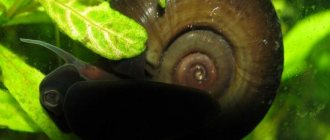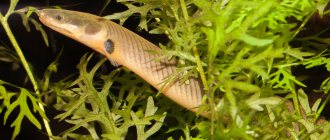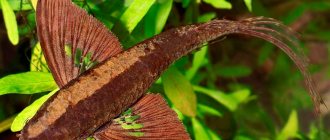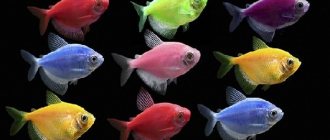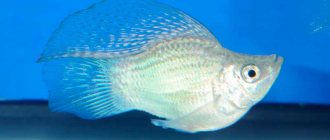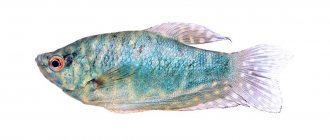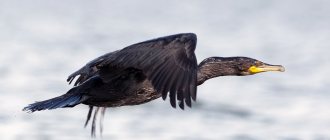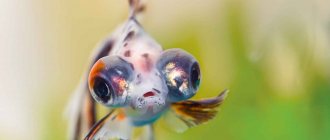The labyrinth type of fish is very popular and loved by many aquarists. Pearlescent gourami, graceful lalius and brightly colored cockerels, unpretentious in terms of keeping conditions, decorate thousands of home aquariums. Less commonly you can find another representative of the labyrinths - the climbing rope, or creeper fish. Although it does not have a bright and memorable appearance, the representative of the species is distinguished by its interesting habits.
Pineapple escapes thirst by burrowing into or crawling into other bodies of water.
External characteristics of the type
The physique of labyrinths is reminiscent of Cichlids: an elongated body reaches 22-25 cm, a large round head, eyes with a reddish tint, and a wide mouth. Aquarium representatives rarely reach more than 15 cm in length. Reliable protection from predatory species is provided by spines located on the anal and pelvic fins, less often at the level of the gill covers. The fins are very developed and strong.
In most cases, the color of the slider fish is brown-green, gray-green or brown. You can meet representatives of orange shades much less often. The dark brown back and yellowish belly are decorated with orange and red fins. Transverse stripes are visible on the sides, from 7 to 10 pieces depending on the size of the individual. The long dorsal fin has sharp spines. Black spots may appear on the body.
Females are not only more subdued in color, but also larger in the abdominal area. On average, sliders live in captivity for no more than 5 years.
Pineapple behavior
Pineapples are aggressive in nature, so they are kept in aquariums only with large species, such as cichlids.
Although crabapples were one of the first tropical species to arrive in Europe, they are not very common among aquarists.
Left without water, these fish do not fall on their sides, but, wriggling, crawl in search of a source of water. Pineapple can travel about 100 meters. Travelers claim that they find these fish even in trees. Therefore, if the crabapples are kept in an aquarium, it must have a secure lid or be covered with glass.
Habitats and diet
The natural habitat of the representative is Southeast Asia. As a rule, relatives of the persimmon can be found in the Philippines, Burma and Indonesia. Representatives of the species prefer fresh or brackish water bodies with slow or completely absent current. The bottom of the reservoir is usually covered with silt. Vast fields of rice, deep ditches and ditches, drying up rivers and shallow ponds are places loved by the creeper fish.
The slider fish is a very aggressive predator, as it feeds on other fish and other small animals that live in water bodies.
An aggressive and cruel predator by nature, in the wild environment it prefers to feed on various small living creatures such as plankton and invertebrates, and in some cases small fish. Home-kept fish prefer:
- dry and granulated fish food;
- rice, herbs and other plant products;
- chopped raw beef;
- small live fish.
Crawlers are famous for their good appetite. Fish breeders must be prepared in advance to keep voracious representatives of labyrinths.
Aquarium fish: how to make the right choice
People who decide to have aquarium fish are faced with a rather difficult question - what kind of pet to choose. If you search well, you will find that you will have to choose from almost 2,000 species of a wide variety of freshwater fish. On this page we tried to collect all the necessary information about the aquarium fish - Pineapple. If you have never had an aquarium before, you don’t need to choose based on the principle of a beautiful fish and an ugly fish. It is necessary to take into account a lot of variables: what kind of food it prefers, the temperature and composition of the water, whether it is a predator or not, whether it is dangerous for humans, whether it gets along with other species, and many other interesting things. If we classify conditionally, we can distinguish two large groups of fish:
- Easy-to-care fish, not at all demanding of environmental conditions, can survive even in unfavorable situations. They have high endurance by nature, because they live in places where water constantly changes its characteristics or even disappears for a while. However, for health and beautiful appearance, such fish need to be provided with conditions as similar as possible to their natural habitat.
- Difficult to care for fish, most of them belong to tropical latitudes. For them, you need to create special conditions in the aquarium, again as similar as possible to the area where they live in nature. These species rarely breed in captivity, so they are brought from the wild.
For a novice fish breeder, it is better to choose one of the most unpretentious species. In addition to the prospect of not being able to cope with caring for a “capricious” fish, there is a danger of introducing an exotic disease that can harm the rest of the flora and fauna of the aquarium. If you liked Pineapple, carefully read the characteristics, character, feeding, care and breeding of these fish.
Unusual Survival Abilities
The slider fish is perfectly adapted to the climatic conditions prevailing in its homeland. Individuals are always ready for the complete or partial drying out of a reservoir during the dry season. It is in this case that they use their rare survival skills, perfected over thousands of years of evolution.
If a lake or river dries out slowly, the climbing perch may burrow deep into the mud, expecting the water to return soon. Individuals create a durable cocoon for themselves that can retain moisture inside for a long time. But if the water level goes down at a tremendous speed, the fish’s inner instinct strongly recommends changing its habitat.
A specific epibranchial organ, called the labyrinth organ, serves the climbing perch for breathing clean air. Thanks to him, the creeper can remain without water for up to several days . Using their developed fins, individuals often crawl ashore and can even climb trees. In this they are helped by miniature spines on the gill plates, which promote enhanced adhesion to any surface. The only reason is to find a habitat suitable for relocation. It is in this way that mass resettlement is carried out to new reservoirs from drying up ones.
The slider fish is able to move on land thanks to its spiny fins.
Compatibility
Anabassoid specimens can be kept in a species aquarium, that is, in pairs. These are active and extremely shy, uncooperative fish. Neighborhood with large cichlids is allowed. They eat slow and small inhabitants. During the day they prefer to hide in shelters. The pugnacious nature does not favor keeping in packs. Unlike adults, young individuals quickly get used to their new habitat.
You can try to accustom a group of Anabas to each other. To do this, more fry are placed in a large tank. Sometimes it is possible to raise individuals that are quite good with their fellows.
Just do not forget that the aquarium must be covered with thick glass. The slider jumps well, pushing off the bottom with its powerful tail.
Features of species reproduction
A slider fish can be considered sexually mature when it reaches 18 months. At this time they begin to spawn. For reproduction, you can give preference to species aquariums or specially created spawning grounds. The optimal temperature ranges from 25 to 30 degrees, permissible hardness is no more than 10, acidity should not exceed 7.5. Aquarium water should be changed frequently.
Traditionally, spawning takes place in the middle layer of water or near the ground. An adult female lays up to 4.5 thousand eggs, which float and drift at the very top of the aquarium.
Since parents are not inclined to protect their offspring, they can be carefully placed in a separate nursery aquarium.
The first fry hatch one day later. After 2-3 days they begin to swim and switch to independent feeding. At first, it is better to feed them rotifers or live dust.
Puberty in fish occurs at 18 months.
Mr. Tail Recommends: Aquarium Basics
In a large container (100-500 or more liters) there should be 10-15 cm between the water horizon and the lid. To recreate low-light conditions, driftwood, branches, stones, algae or roots are placed at the bottom, and a layer of floating vegetation is also made.
Description of water characteristics:
- pH - 6.8-8.0;
- temperature - +23...+26 °C;
- hardness - 20 °dH.
The filter is selected so that it does not create significant water movement. Weekly fluid replacement is 15–20%. Aeration is not necessary. The soil - dark sand or pebbles - is cleaned with a siphon every 7-10 days.
Slitherfish and man
In Asian countries, the slider fish is a commercial fish. People not only catch them, but also breed them on special farms. In addition to its pleasant taste, persimmon meat is famous for its benefits for male strength . It has a huge demand at farmers' markets. The meat, considered a delicacy, serves as an ingredient in many delicious oriental dishes.
In addition, many naturalists keep the climbing perch as a pet. But the fish, unpretentious to its living conditions, has a very aggressive disposition, so the list of neighbors who can get along with it is very limited.
Optimal conditions of detention
Anabas testudineus easily adapts to life in captivity. You just need to control the following points:
- Choosing an aquarium. It is optimal to keep them in a separate species container, the volume of which will be at least 95 liters for a pair of labyrinths. Because of the love and ability of the fish to move, the aquarium needs to be covered with thick glass. Attention: 10 cm is the minimum distance between the glass and the surface of the water.
- 26 degrees is the ideal water temperature for life and reproduction of individuals. The hardness and acidity of water should be moderate. Every week you need to change at least 20% of the volume of the aquarium. Experts recommend installing a reliable filter.
- Pisces prefer dim, slightly diffused lighting.
- You can plant ornamental plants in the container, but we must not forget about free space for the movement of individuals and their spawning.
- You can decorate the aquarium with carefully processed stones and driftwood. They will serve not only for aesthetics, but will also become reliable shelters for the peaceful neighbors of the Anabass. This will help significantly reduce the number of conflicts.
- Comfort can be increased by creating islands of land where individuals can go for a breath of fresh air.
- To remove the slider for changing water or relocating, you should use the thickest fabric net or glass vessel. Otherwise, the fish may get caught in the fabric by the spikes and be seriously injured.
To keep the creeper fish, you need a separate container, since the climbing rope is very difficult to live with.
Recommendations when buying fish for the first time
- Dimensions and shape of the aquarium . You need to decide what size aquarium you can place at home. Also, when choosing a place, you need to take into account the needs of future pets: water temperature, lighting and other nuances. In the pet store, the fish are often still babies who will grow up, and perhaps they will be cramped.
- Fish sizes . The law of nature - the strong eats the weak - also applies to the inhabitants of the water kingdom. Even if the fish is not a predator, but larger in size, it can swallow babies. Smaller fish will always hide and get scared, sometimes refuse food when a much larger fish is nearby.
- Character and habits of fish . You need to find out in advance what your pet's temperament is. After all, fish have their own kingdom, where they can sometimes jealously defend their territory, show excessive activity or aggressiveness if they are predators. When choosing different species, you should make sure that they get along well with each other.
- Relationship within a species . Several males of the same species can get along well, without any conflicts, while others, on the contrary, will not be able to calm down until they survive their competitor. This applies to fighting fish, as well as some species of cichlids. Some breeds live exclusively in a pack, but alone they can simply die.
- How to feed properly . Find out what the fish you like prefers to eat. Some people like to eat dry food, while carnivores only serve meat or even live food. You need to decide whether you will have the opportunity to constantly buy worms, live bloodworms, larvae and other living creatures. And this “food” will need to be stored in the refrigerator, next to your food.
- Correct conditions for keeping . Each fish, including Pineapple, requires an individual approach, so these nuances need to be clarified in advance. There are species that are really difficult to maintain, both in terms of time and finances. This species includes Discus. And many people know Guppies, they are not picky at all and do not require special care. Separate requirements for water, because different breeds of fish live in different water: temperature, hardness, salinity. Selected pets can eat the same food and get along well together, but one requires warm water, and the other cooler. As a result, it turns out that the species are not compatible after all.
- How and where to buy Pineapple . Carefully choose the place where you want to buy Pineapple. If this is a pet store, pay attention to the conditions in the premises, how the staff cares for the fish, and evaluate the reputation of the establishment. This will allow you to create an overall impression of the seller and decide whether something is worth buying from this place.
Story
In 1792, the persimmon was described and systematized by the German naturalist and ichthyologist M.E. A flea called Anabas testudineus. The fish belongs to the creeping family, the genus Anabass, which includes 2 species (Anabas testudineus and Anabas cobojius). In Europe, the Anabass appeared in the exhibition of the London Zoological Park in 1870. The creeper fish arrived in the USSR only in 1960. In some countries, there are fish farms that breed Anabas not only for sale in aquariums, but also for tasty meat.
